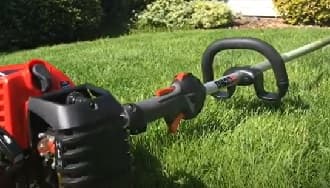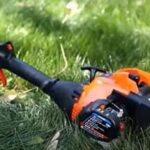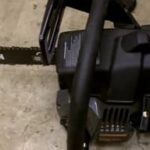As an Amazon Associate, this site earns commissions from qualifying purchases. For more information click here.
Speaking from personal experience, Echo weed eaters are pretty reliable. But just like any other machine, there will be times when it won’t start. This is frustrating I know, so I will show you the most likely reasons why and the best fixes.
A dirty air filter, faulty spark plug or clogged carburetor will prevent an Echo weed eater from starting. Other possible causes are a defective fuel filter or damaged primer bulb.
Poor Quality Fuel
There are two things you should always keep in mind: use high quality fuel and make sure that is ethanol-free.
Ethanol is bad for weed eaters. It takes a while to notice the effects, but by then the damage has been done. This applies to other small engines too, so avoid ethanol.
Second, use high quality fuel. I prefer premixed fuel like VP Racing because it is convenient. If you want to prepare the mixture, the ratio is 50:1.
Broken Rewind Spring
When you pull and let go of the starter rope, its rewind spring pulls the rope back into the rewind pulley.
If the rewind spring, pulley or spring is damaged, the starter rope will not be able to recoil. Because of this your Echo string trimmer will not turn over.
There are two ways to fix this: replace the rewind spring or the entire spring pulley. I recommend replacing the whole assembly.
Clogged Fuel Filter
Fuel filters prevent contaminants from seeping into the engine. Think of it as a strainer that catches particles before they can mix with the fuel.
If the filter isn’t working, the engine could end up with dirty fuel and this can lead to a complete stop. This is one of the most important parts of a weed eater so its maintenance is essential.
This video shows you how to remove an Echo string trimmer fuel filter. While some recommend cleaning, it’s better to replace the filter with a new one.
Damaged Recoil Starter
The recoil starter is what allows the crankshaft to turn an Echo weed eater engine over. A faulty recoil starter assembly prevents the crankshaft and engine from working.
You can test the recoil assembly to see if it is working. Remove the assembly and pull the starter rope. Tabs from the cam and pulley should extend and hold the engine hub. This is what makes the engine turn.
Once you let go of the rope, the tabs will draw back and the rope retracts to the pulley. If this does not work, the recoil starter assembly has to be replaced.
This is applicable to Stihl string trimmers too. For more on this, check out my guide on why Stihl string trimmers won’t run.
Blocked Spark Arrestor
A spark arrestor is used to prevent engine fire. It is an important safety feature obviously and must always be in working condition.
Spark arrestors can get clogged by dirt and deteriorate due to heat. If you suspect there is a problem, remove the spark arrestor.
It’s either going to be clogged with dirt or suffering from heat damage. In both cases I suggest replacing it.
You can clean a spark arrestor, but if it has gotten to the point it no longer works, then there’s a lot of clogging already. Might as well get a new one since they are inexpensive.

Defective Spark Plug
Examine the spark plug for any indication of damage or if it is covered by carbon. Replace the spark plug if there is warping, cracks, carbon buildup or blackening / burning.
Use a spark plug tester like Ram Pro if you are not sure. Crank the engine while you run the tester. If the spark plug is working, the terminals should spark. If it doesn’t, the spark plug is defective and must be replaced.
Damaged Primer Bulb
The primer bulb primes the engine fuel. It looks like a bulb (hence the name) and when activated, fills up with fuel and transmits it to the carburetor.
If the primer bulb isn’t working, fuel will not reach the carburetor and the engine will turn over. Based on my personal experience, primer bulbs only get damaged if you press it repeatedly too much or due to wear and tear. If your Echo trimmer is new this should not be an issue. Even an old weed eater, if well maintained, should have a functional primer bulb.
Fuel-Clogged Carburetor
Carburetors get clogged by fuel residue and contaminants. If you don’t replace the fuel for a long time, some of its elements dissipate and produce a sludgy, viscous substance.
Use a carburetor cleaner to remove the residue. I prefer Gumout because it only takes a small amount to clean the carburetor again.
Adjust the Carburetor. If you already cleaned it but your Echo string trimmer still won’t start, some adjustment might be needed. This video explains how to adjust a small engine carburetor. If that still doesn’t work, the carburetor has to be replaced.
Defective Air Filter
An air filter keeps dirt away from the engine, but it has to be cleaned or replaced regularly. A dirty air filter blocks air and prevent your Echo string trimmer from running.
The air filters should be cleaned after every 5-8 hours of use. Replace the air filter if it is too dirty or damaged.
I strongly suggest that you buy an Echo air filter as a backup. If you have to replace the air filter and don’t have any available, it can be frustrating. You should not run your Echo string trimmer without an air filter, so having a replacement is ideal.
Clogged Tank Vent
String trimmer fuel tanks have an air vent. If the vent is clogged, the fuel tank will produce a vacuum and prevent fuel from flowing into the engine.
If your Echo weed eater starts and stalls or refuses to run at all, loosen the fuel tank lid. If the engine runs fine with a loose cap, it means the vent is clogged.
How to replace an Echo string trimmer tank vent:
- Take off the air cleaner assembly including the lid.
- Take out the air filter.
- Empty the fuel tank.
- Look for the fuel tube. The vent is in it.
- Carefully pull the fuel tank vent out.
- Take off the metal clip on the vent tube.
- Draw the vent tube up and out of the tank grommet.
- Place the metal clip on the vent tube 1/4 in. off the end.
- Place the new tank vent on the vent tube.
- Set the tank vent and vent tube at the back of the fuel lines.
- Put the air filter onto the air cleaner cover.
- Place the air filter cover back on.
Engine is Flooded
Flooding occurs when too much fuel flows into the carburetor. This usually happens if the primer bulb is pressed too often.
The carburetor can also get flooded if the starter rope is pulled too often while the choke is off/closed. I have also seen this occur when the starter rope is pulled with the switch off.
To un-flood an Echo weed eater:
- Set the switch to “run” and open the choke.
- Squeeze the throttle and pull the starter rope. Pull the starter rope 12-15 times without letting go of the throttle.
After 12-15 pulls you will hear the engine cough. Keep pulling until it starts.
Seized Engine
Let’s take a look at the most likely causes for an engine seizure and the solutions.
Lack of fuel. Check the fuel tank. There should be a mark indicating how much fuel is required. Too much or too little will cause engine issues.
Faulty spark plug. Replace the spark plug if it is covered with oil residue or damaged. I recommend replacing the spark plug at the end of each season or after 25 hours of use, whichever comes first.
Poor air circulation. Check the air filter, spark arrestor and fuel tank vent. Clean or replace them if clogged or damaged.
No Battery Power
If you are using a cordless Echo weed eater, the battery could be running low on power. Until you recharge the battery, the motor cannot run.
Battery-powered string trimmers don’t last as long as gas models. If you trim large, thick grass, it’s going to lose power quickly.
Charge the battery to full power before you do any yard work. The manual should give you a general idea how long it’s going to last. If the battery discharges too quickly, you may have to replace it.

I love the outdoors and all the tools for maintaining gardens, yards and lawns. The only thing I am more passionate about is sharing what I know about garden and outdoor equipment.


